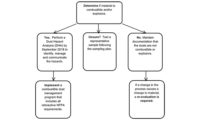LOTO standard exemptions can save time – if followed correctly
Optimize your operations

OSHA’s Control of Hazardous Energy standard -- the Lockout-Tagout rule -- (29 Code of Federal Regulations (CFR) 1910.147) addresses the safety of employees engaged in servicing and maintenance activities in general industry when exposure to the unexpected release of hazardous energy is possible. The standard incorporates performance requirements which allow employers flexibility in developing lockout-tagout programs suitable for their particular facilities.
The standard does not cover:
- Construction and agriculture employment covered by 29 CFR 1915, 1917 and 1918;
- Installations under the exclusive control of electric utilities for the purpose of power generation, transmission and distribution, including related equipment for communication or metering;
- Exposure to electrical hazards from work on, near, or with conductors or equipment in electric-utilization installations, which is covered by 29 CFR 1910 Subpart S; and
- Oil and gas well drilling and servicing.
For every rule there seem to be exceptions. And that certainly is true for the Lockout-Tagout standard. Misunderstanding when an exception is applicable could be costly.
Minor servicing exception
Normal production operations, the utilization of a machine or piece of equipment to perform its intended production function, are not covered by the Lockout-Tagout standard. Rather, they are covered by the Machine Guarding standards in 29 CFR 1910 Subpart O.
Servicing and/or maintenance which takes place during normal production operations is covered by the Lockout-Tagout standard if an employee is required to:
- Remove or bypass a guard or other safety device; or
- Place any part of his/her body into an area on a machine or piece of equipment at the point of operation or where an associated danger zone exists during an operating cycle.
Generally activities such as lubrication, cleaning or unjamming, servicing of machines or equipment, and making adjustments or tool changes, where the employee may be exposed to the unexpected energization or start-up of the equipment or release of hazardous energy, are covered by the Lockout-Tagout standard.
For a task to be considered as minor and meeting the minor servicing exception it must meet the following three criteria:
- Conducted during normal production operations;
- Must be routine, repetitive, and integral to the operation; and
- Must use alternate measure to provide effective protection.
The employer bears the burden of demonstrating, on a case-by-case basis, that the minor servicing exception applies. The activity must be conducted during normal production operations ( i.e., while the machine or equipment is actually performing its intended production function). The activity must be a regular course of procedure and in accordance with established practices, regularly repeated as part of the production process and essential to the production process.
If the task is performed during normal production and is routine, repetitive, and integral, the employer must use alternative measures to provide effective protection from the hazardous energy. Some acceptable alternative measures include specially designed tools, remote devices, interlocked barrier guards, local disconnects, or control switches which are under the exclusive control of the employee performing the minor servicing. These alternative measures must enable the employee to safely perform the servicing task without being exposed to the unexpected energization or activation of the equipment, or the release of stored energy.
Cord-and-plug connected electric equipment exception
One of the most commonly misunderstood exceptions is the cord and plug exception. Lockout-Tagout procedures do not have to be implemented when servicing or maintaining cord-and-plug connected electrical equipment IF complete de-energization of the equipment is achieved by:
- Unplugging the power cord from its energy source; and
- The plug is kept under the exclusive control of the worker performing the service and/or maintenance activity.
Unplugging the equipment must address all energy sources. Several pieces of equipment still pose a hazard even after the electrical power source has been cut off or unplugged due to residual energy. For example, unplugging a compressor does not eliminate the residual pneumatic energy in storage tanks, cylinders and transmission lines. And electrical equipment with capacitors may still hold an electrical charge even though the plug has been unplugged from the outlet.
Also, the plug must remain “under the exclusive control” of the employee performing the work. “Exclusive” means if two or more employees are working on one piece of equipment, this exception is not applicable. “Control” means the plug must constantly remain in the possession of the worker performing the work – holding the plug, sticking the plug in their pocket – or in arm’s reach and the line-of-sight of that worker. If that is not possible, then the plug must be secured with a lockout-tagout device.
Hot tap operations exception
Hot tap is a procedure used in the repair, maintenance and services activities which involves welding on a piece of equipment (pipelines, vessels or tanks) under pressure, in order to install connections or appurtenances. It is commonly used to replace or add sections of pipeline without the interruption of service for air, gas, water, steam, and petrochemical distribution systems.
Hot tap operations are exempted from the Lockout-Tagout standard if the employer can demonstrate that:
- Continuity of service is essential;
- Shutdown of the system is impractical;
- Documented procedures are followed; and
- Special equipment is used which provides effective employee protection.
Energy control procedure exception
OSHA has defined eight criteria that a specific machine or piece of equipment must meet to be exempt from requiring a documented energy control (lockout/tagout) procedure (29 CFR 1910.147(c)(4)(i). All eight criteria must be met. Failure to meet even one will result in the equipment needing a documented machine-specific energy control procedure. The criteria are:
- There can be no potential for stored or residual energy or re-accumulation of stored energy after shut down;
- The machine or equipment must have one single energy source which can be readily identified and isolated;
- The machine/equipment must be completely deactivated by the isolation and locking out of the identified single energy source;
- The machine or equipment is isolated from that energy source and locked out during servicing or maintenance;
- The machine or equipment must be controlled and locked out by use of a single lockout device;
- The lockout device is under the exclusive control of the authorized employee performing the servicing or maintenance;
- The servicing or maintenance does not create hazards for other employees; and
- There have been no accidents involving the unexpected activation or re-energization of the machine or equipment during servicing or maintenance.
For many there is still confusion regarding these criteria. Given below are some examples of equipment/machines that are commonly thought to fall under this exemption, but do not:
- Exhaust fans have electrical and residual moving parts energy sources.
- Trash compactors have electrical energy and stored hydraulic and pneumatic energy sources.
- Overhead doors have electrical, pneumatic and hydraulic energy sources.
- Mills, lathes and drills all have electrical and kinetic energy sources and possibly hydraulic or pneumatic sources.
Conclusion
Exceptions to the Lockout-Tagout standard can help employers optimize the operation and maintenance of equipment by reducing the time it takes for the tasks to be completed, but employers must ensure that when used the same or greater level of protection as afforded by locking-tagging out is provided.
Looking for a reprint of this article?
From high-res PDFs to custom plaques, order your copy today!





